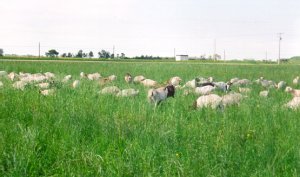Choosing a Mineral for Your Goat Herd
There are many different kinds of minerals available for goat producers. There are salt free minerals, there are salt containing minerals, there are minerals that contain selenium and some that don't contain selenium and then there are 1:1 or 2:1 minerals. Most minerals contain vitamin A, but what concentration of vitamin A is enough?

Minerals are used to supply calcium (Ca) and phosphorus (P) along with other macro and micro (trace) minerals to your goat. Goat and all livestock must have minerals in order to grow and produce kids and milk. Minerals are important for bone development, muscle contraction and many enzymes and hormones critical for maintaining the well being of an animal. Unlike sheep, goats are not susceptible to copper poisoning. You can feed high copper minerals to goats.
Minerals come with a tag that has two numbers on it, i.e. 18:18 or 18:9. These two numbers are the concentration in % of Ca and P in the mineral. An 18:18 mineral contains 18% Ca and 18% P and it is also usually salt free. An 18:9 mineral has twice as much Ca as P and is often called a two to one mineral. A two to one mineral is designed to be fed to feedlot animals that are on a high levels of grain feeding. The tag on the bag of mineral will give you the concentration of the trace minerals in the mineral.
When you need to supply Ca to your goat, especially when on high grain diets, i.e. feedlot kids, it is much more economical to supply Ca from limestone (calcium carbonate). Grain is a good source of P but it contains no Ca. Limestone is 38% calcium and it is cheap to buy. When buying limestone make sure to tell the feed mill/store that you want to buy the product that has the consistency of salt and not flour. The flour product is hard to work with, to much dust!
Phosphorus is the most expensive mineral to buy. It can be difficult to tell which bag of mineral is the best buy. Always compare two bags of mineral based on the cost of the P in each. For example:
You have the choice between mineral #1 which is an 18:18 that cost $20.00/55 lb bag or mineral #2 which is an 18:9 that cost $16.00/55 lb bag, which choice is the better deal? The first calculation is to calculate the amount of P in each bag. For #1 the calculation is 0.18 X 55 lb = 9.9 lb of P and for #2 the calculation is 0.09 X 55 lb = 4.95 lb of P. Next you need to calculate cost ($) for each lb of P. for #1 the calculation is $20.00/9.9 lb for a cost of $2.02/ lb of P and for #2 the calculation is $16.00/4.95 for a cost of $3.23/ lb of P. This calculation shows that the more expensive bag of mineral (#1) is a much cheaper source of P. Remember to do this calculation when comparing two minerals to make sure you are getting the best deal.
You can use a mineral salt mixture to supply vitamin A, D & E to your goat. Goats will eat about 1-ounce (28 g) of mineral on a free choice basis when there is no other source of salt available. If a doe needs 7,000 IU of vitamin A the mineral mixture will need to contain about 300,000 IU of vitamin A per kg. When buying a mineral, look for the product that has the highest concentration of vitamin A. The concentrations of vitamin D and E are added in proportion to the amount of vitamin A. Some minerals contain up to 500,000 IU of vitamin A per kg. This is a good level of supplementation.
If you cannot find a mineral with a high enough vitamin concentration, you can buy a vitamin premix to fortify the mineral. Vitamin premixes are a very concentrated source of vitamins. A little goes a long way. Most premixes come in two strengths, 10 million IU/kg or 30 million IU/kg. Talk to a nutritionist or a specialist before using a premix. Vitamin premixes can also be bought with or without selenium (Se). If white muscle disease or retained placentas is a problem in your herd make sure you are feeding Se. Remember that Se becomes toxic quickly, so do not overfeed it. If in doubt, consult with a nutritionist.
Minerals that contain salt usually are consumed better than salt free minerals. Some salt free minerals have flavourings added to encourage intake. You may notice that a fresh bag of mineral has liquorice like smell when opened. Some feed companies use dried molasses to encourage intake. A doe will eat close to ? lb. of mineral a week. To monitor intake, put out mineral fresh once a week. Put it where it will not be rained on, and it will not be blown out of the feeder by the wind. For some reason, unknown to me, animals tend to eat a lot more mineral in the fall and winter compared to the spring and summer.
Prepared by: Rob Berry - Dairy Specialist, Manitoba Agriculture and Resource Development

